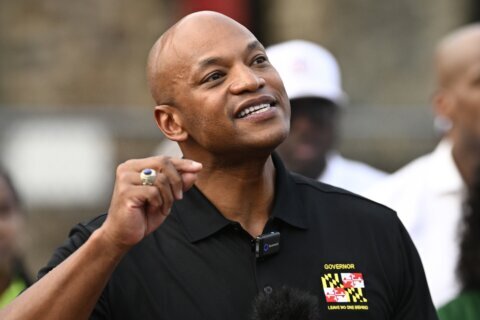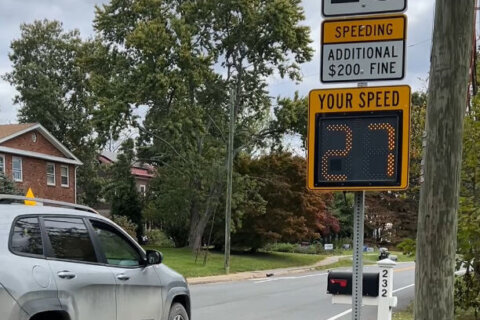This article was republished with permission from WTOP’s news partners at Maryland Matters. Sign up for Maryland Matters’ free email subscription today.
Maryland voters will have the chance to weigh in this fall on Question 1, a ballot measure that would amend the state constitution to enshrine “reproductive freedom,” a change supporters say will protect access to abortion, among other procedures.
But anti-abortion advocates say there’s a problem: The word “abortion” does not show up in the proposed amendment language.
That’s true. The word “abortion” will not appear on ballots this election cycle, even though the constitutional amendment is billed by advocates to protect one’s right to an abortion.
Opponents call that a legal loophole “you can drive a Mack Truck … through,” and have put forth any number of far-reaching possible scenarios the amendment could allow.
Supporters say opponents are just “making stuff up” to confuse voters on an issue that has overwhelming support — a recent poll said 69% of those surveyed plan to vote for Question 1, compared to 21% who will vote no. Even though the word abortion is not on ballot, they said, there’s no way the amendment can be interpreted otherwise.
Secretary of State Susan Lee certified the official ballot language in June. It states, in part, that “the proposed amendment confirms an individual’s fundamental right to reproductive freedom, including but not limited to the ability to make and effectuate decisions to prevent, continue or end the individual’s pregnancy.”
On July 16, Secretary of State Susan Lee certified ballot language for the Right to Reproductive Freedom referendum: “The proposed amendment confirms an individual’s fundamental right to reproductive freedom, including but not limited to the ability to make and effectuate decisions to prevent, continue or end the individual’s pregnancy, and provides the State may not, directly or indirectly, deny, burden or abridge the right unless justified by a compelling state interest achieved by the least restrictive means.”
Voters will choose between “For the Constitutional Amendment,” “Against the Constitutional Amendment,” or leave the question blank.
Erin Bradley, chair of Freedom in Reproduction-Maryland (FIRM), said supporters would have preferred the term “abortion” be used in the ballot language, but it’s not a large issue for them.
“National polling experts have shared with me that when the word ‘abortion’ is in the language, it performs better,” she said. “So, we would have liked to have said, ‘You can prevent a pregnancy through birth control, you can end a pregnancy through abortion,’ but it doesn’t.”
Bradley said the ballot measure, if successful, would still protect the right to an abortion even though it “doesn’t say it outright.”
“The ballot language speaks to the person having the right to make and effectuate their own decisions about preventing a pregnancy — so that covers birth control. About maintaining their pregnancy unfettered — so staying pregnant as they would like and starting a life as they would like. Or to end a pregnancy — which covers abortion,” Bradley said.
Anti-abortion advocates counter that the ballot measure is not limited to just abortions but “paves the way for all kinds of” other medical procedures, according to Jeffrey Trimbath, president of the Maryland Family Institute.
Mail-in voting has already started and almost 70% of Marylanders in a recent poll said they are broadly in support of “adding an individual’s right to reproductive freedom to the Maryland state constitution.” That leaves Trimbath and other opponents with a steep climb to convince a majority of Marylanders to vote against Question 1.
They have latched onto the fact that “abortion” doesn’t appear in the amendment language “because, fundamentally, it’s not about abortion.”
“It’s about undermining parental rights,” he said.
Trimbath and other anti-abortion organizations, like Maryland Right to Life and Health Not Harm MD, say the ballot measure does not explicitly exclude minors, and would overstep a parent’s ability to “influence the health care decision of their kids, and that includes abortion,” he said.
He also argues that the bill language would include gender-affirming care by “being able to take away reproductive function.”
“And that certainly is in the transgender space, where you have hormones and surgeries that do these things,” Trimbath said. “The fact that the word ‘abortion’ doesn’t appear tells us it’s not primarily about that subject, it’s about undermining parental rights.”
He said that as written, the ballot initiative isn’t clear on “what it includes or doesn’t include.”
“‘Including but not limited to …’ My goodness, you can drive a Mack Truck, legally speaking, through that phrase,” Trimbath said. “So we think that this just paves the way for all kinds of things.
“We don’t know what it includes or doesn’t include,” he said. “And you can try to guess, but I would take the amendment at its word — at its expansive ordinance.”
Katie Curran O’Malley, retired Baltimore City District Court judge and current executive director of the Women’s Law Center of Maryland, agrees that the ballot language is broad, but says it is “not vague at all.”
“People get hung up on that sentence that says it confirms an individual’s fundamental right to reproductive freedom ‘including but not limited to,’” she said. “And then they just start making stuff up and saying that means there’s maybe gender-affirming care.

“Not using the word ‘abortion’ is intended to reflect the broad sort of reproductive health services that people need to have protected, that are being attacked now,” O’Malley said. “I would argue that this language is not vague at all — it is broad though. It has to capture those large number of reproductive services that people want to have.”
She noted that while transgender individuals may still need access to abortion and other services, gender-affirming care is separate from reproductive health care.
“It says clearly in the amendment — decisions to prevent, continue or end an individual’s pregnancy … all of those reproductive health services which are completely different from gender-affirming care,” she said.
Bradley with FIRM said the ballot initiative does not cover gender-affirming care or override current state law about minors receiving medical care without parental consent.
“What this does not do: it does not change anything in existing law or statute about parental notification, who can and cannot give or provide an abortion, it doesn’t change any of the medical standards or any of the practices related to the provision of health care,” she said. “Only that no one can interfere with your right to have that health care.”
But Trimbath counters a change to the Maryland Constitution would trump state statute.
“Since it … will amend our state’s constitution, by definition, it will be the supreme law of the land. It will supersede every other state statute having to do for health care with minors,” he said.
Sharon Blugis, founder and legislative director of Reproductive Justice Maryland, says opponents are clutching at straws, and she is not surprised they are looping parental rights concerns and transgender issues in to their arguments against the amendment.
“This is their MO — it’s what they do. It’s the same stuff over and over and over and over. Doesn’t have to be true for them to do it,” she said. “There is not one iota or anything that would allow a child to have any kind of sex operation.”
“It’s outrageous, but it works. It won’t hit in this state as much as it will in Ohio, Missouri or Florida,” she said. “But it gets people all worked up if they’ve never actually read the bill … or the ballot language.”







